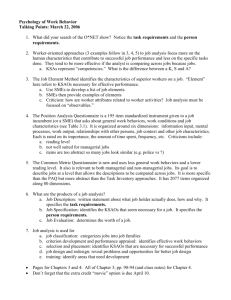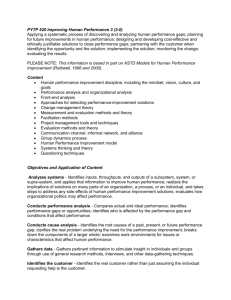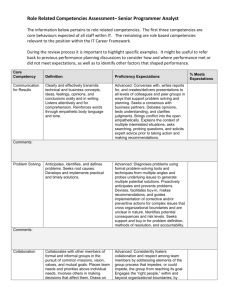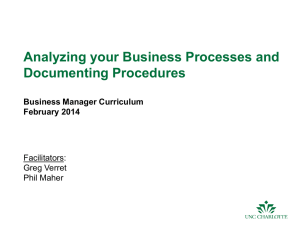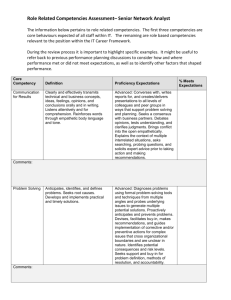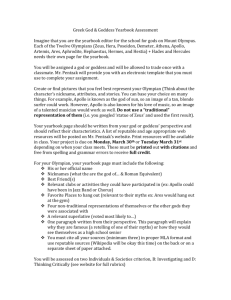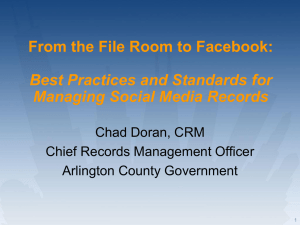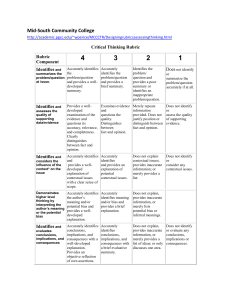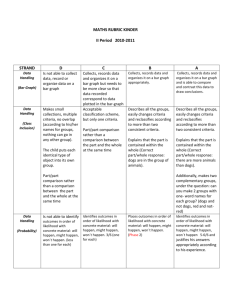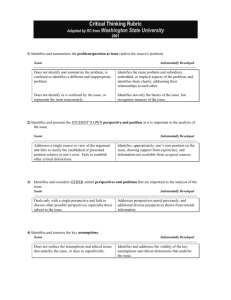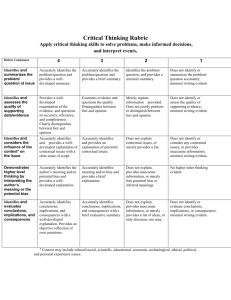Test Planning
advertisement
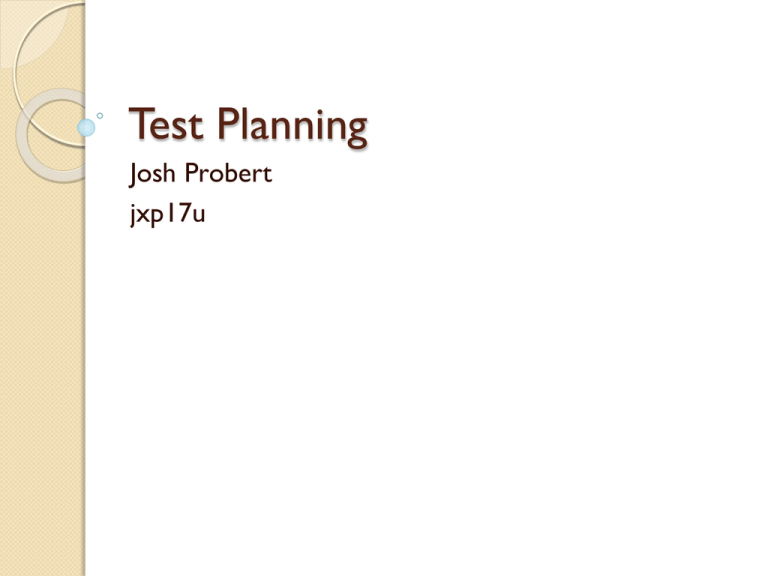
Test Planning Josh Probert jxp17u Introduction Software testing is a formal process carried out by a committed testing team in which a piece of software, parts of software or even multiple pieces of software are examined to detect differences between existing and required conditions. Why do we need to plan for it? ◦ Testing is a complex process ◦ Test planning is essential in: ensuring testing identifies and reveals as many errors in the software as possible bringing software to an acceptable level of quality giving efficiency regarding budgetary and scheduling limitations. ◦ IEEE Standard for Software Test Documentation defines Test Planning as “a document describing the scope, approach, resources and schedule of intended testing activities” What is a Test Plan? A Managerial Document An ongoing process throughout the project lifecycle with test plans being developed for each phase of software development: ◦ Integration test plan, Unit test plan, Acceptance test plan Successful test planning enables the mapping of tests to the software requirements and defines the entry and exit criteria for each phase of testing. No test plan??? “He who fails to plan, plans to fail.” ◦ ignorance of software problems ◦ breaching financial and scheduling limits ◦ contrasts in expected quality and end quality Levels of Test Plan The Level of Test Plan defines what the test plan is being created for e.g. subsections of testing: Integration, Unit, Acceptance A Test Plan document will follow the same structure for each level of test plan. The only difference being the content and detail. Hierarchy of Test Plans will exist: ◦ What is a Master Test Plan? Note: All Test Plans must agree The Test Plan Document Test Plans follow a strict structure to ensure all aspects of testing are covered. This is stated by the ANSI/IEEE 829-1988 Test Plan Structure: 1. Plan Identifier 8. Suspension Criteria 2. Test Items 9. Test Deliverables 3. Risk Issues 10. Environmental Requirements 4. Features to be Tested 11. Staffing/Training Needs 5. Features not to be Tested 12. Schedule of Test 6. Test Approach 13. Planning for risks 7. Pass/Fail Criteria 14. Approvals Plan Identifier A test plan document will commence with a unique test plan identifier ◦ Unique company generated number ◦ Identifies the Test Plan, it’s test level and the level of software it’s related to Why do we need an Identifier? ◦ Software Document ◦ To assist in coordinating software and test ware versions Revision numbers are also used Example: RS-MTP01.3 Test Items Identifying the test items is a section that basically specifies the things that are to be tested within the scope of this test plan: ◦ Functions of the software ◦ Requirements stated in the Design stage The Test Plan should ensure correct names and versions are listed Software and hardware needed for testing will also be listed here, along with other test materials and participating organizations. Example: ◦ EXTOL EDI package,Version 3.0 Software Risk Issues All risks associated with the software and its testing need to be identified in this section. Why?? ◦ Plan for risks and contingencies This could include complex functions, new versions of cooperating software, etc... Test planners should be aware of: ◦ Vague, unclear or un-testable requirements ◦ Misunderstanding of requirements Example: ◦ Backup and Recovery of the EDI transmission files, local databases and restart of the translation process, must be carefully checked. Features to be Tested This section identifies the features to be tested from a user’s point of view. It differs significantly in comparison to “Identifying Test Items” ◦ Low-level non technical descriptions ◦ Level of risks identified Example: ◦ Redesigned On-line screens. Features not to be Tested This section lists the features not to be included in the testing process, identifying the reason behind its exclusion. ◦ Used before? Deemed stable and reusable? ◦ No intention of releasing with software? This section of a Test Plan is directly associated with previous sections; what will and will not be tested is directly affected by levels of acceptable risk within the project. ◦ If a feature does not get tested it affects the level of risk of the project Test Approach This section identifies the strategy for this test plan, differing depending on the level of test plan (Unit, Integration, Acceptance) The approach stated should be appropriate and in agreement with all higher and lower levels of test plans The level of detail of this section differs depending on the level of test plan. For example, a Unit test plan will go into much detail on individual unit tests and test data. The bulk of information on testing techniques and methodologies will be included in this section Test Pass/Fail Criteria This section identifies the pass and fail criteria appropriate to this test plan Unit Test Plan: ◦ All test cases complete? ◦ Automated testing tool indicated all line of code covered? Master Test Plan: ◦ All lower level plans completed? A successful Test Plan should indicate when a project stage can or cannot proceed Suspension Criteria involves identifying when pausing during a series of tests is necessary. E.g. if the number of defects reaches a point where the follow on testing has no value, it makes no sense to continue the test and waste resources A test planner should specify what constitutes stoppage for a test and what is an acceptable number of defects to allow testing to continue Test Deliverables This section is used to specify what is to be delivered as part of this test plan Note: One thing that is not a test deliverable is the software itself! Examples of Deliverables: ◦ Test logs ◦ Incident reports ◦ Outputs ◦ Corrective actions taken Environmental Requirements states any special requirements for this test plan including necessary hardware and software required for testing to proceed. Documenting the physical components required for test execution helps to identify potential gaps in what is required and what actually exists Example: ◦ Access to a nightly backup/recovery system Staffing/Training Needs This section identifies all personnel and the hierarchies relevant to the test plan. This includes all areas of the plan such as setting risks, selecting testing and non-testing features, scheduling and most importantly critical go/no go decisions. Example: ◦ Staff will require training on new equipment Schedule of Test Scheduling should be based on realistic and validated estimates for software testing Milestones should be identified with schedules being specified for each milestone Depending on the level of test, the size of this section will differ, e.g. Master test plan will involve all the test plan schedules below it making it fairly large. Dependant/Relative Dating Planning for Risks and Contingencies This section aims to identify the overall risks to the project with an emphasis on the testing process. Identified risks are then given possible solutions. Think back to “Risk Issues” ◦ “Backup and Recovery of the EDI transmission files, local databases and restart of the translation process, must be carefully checked.” The section should in turn identify how to plan for risks stated earlier in the test plan. Approvals Approvals states who can consent a process as complete and allow the project to proceed to the next stage. This depends on the level of test plan and can differ from a test team leader to a more executive employee The type of knowledge at each level of test plan differs significantly. For example, programmers may understand the technical side of software but not the managerial or commercial side. Summary A Test Plan is a managerial document that has many levels differing in content and depth. We have Test Plans to ensure testing stages are performed to the best quality. IEEE 829-1998 Standard provides us with a Test Plan Structure to successfully plan for testing stages Without a detailed Test Plan, problems will no doubt arise! Questions?
